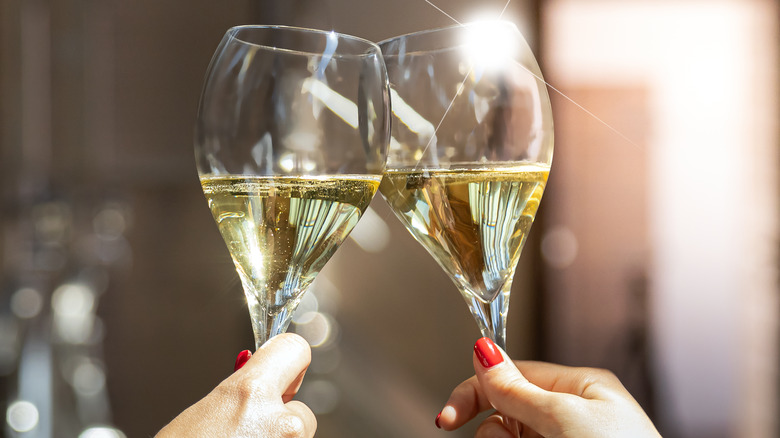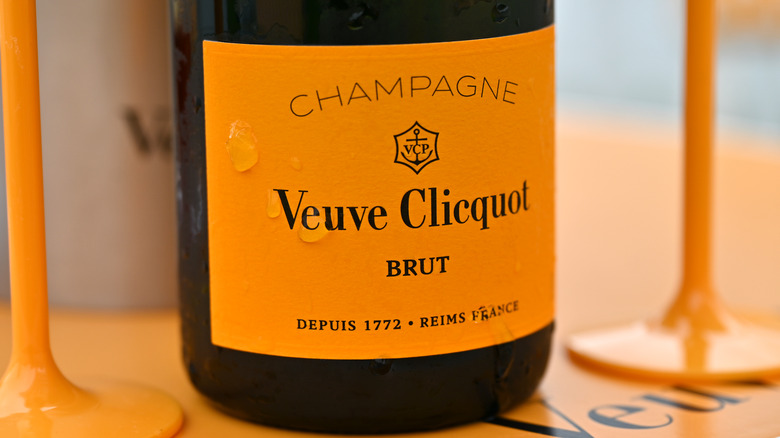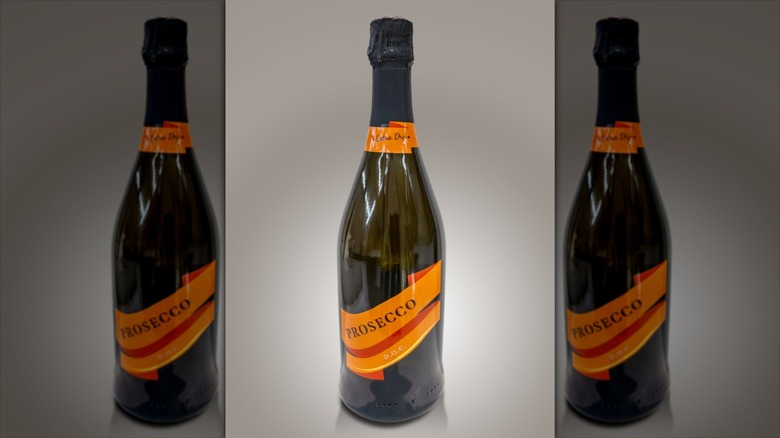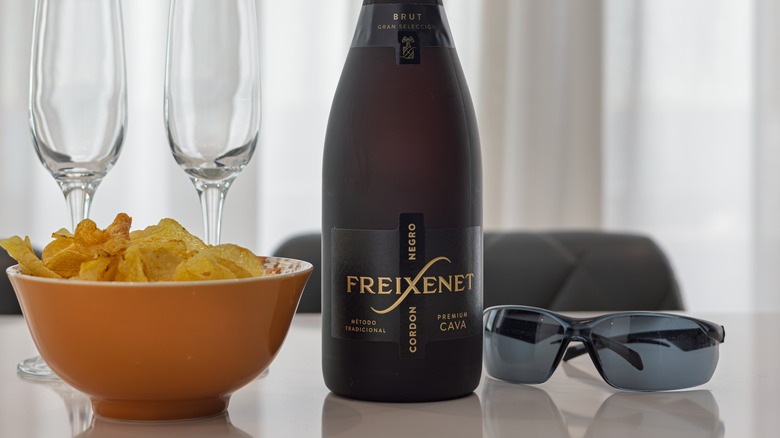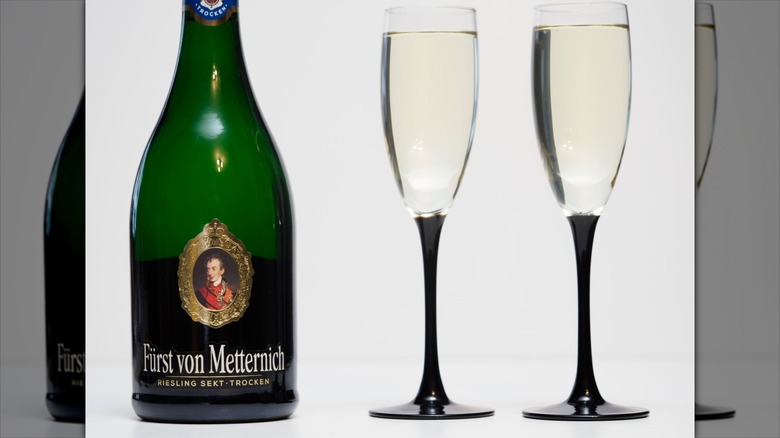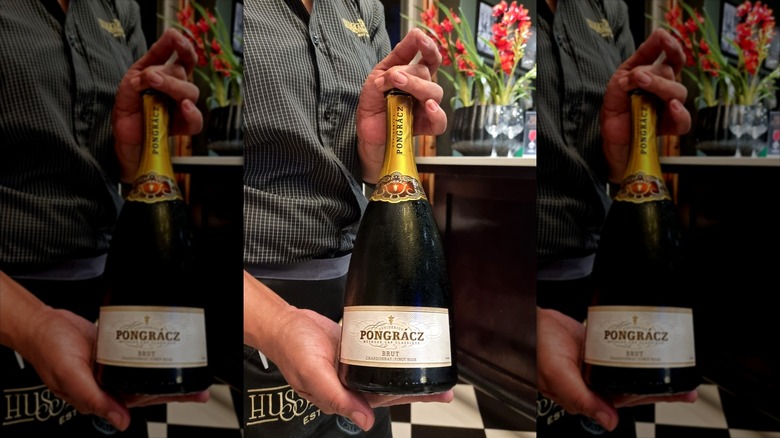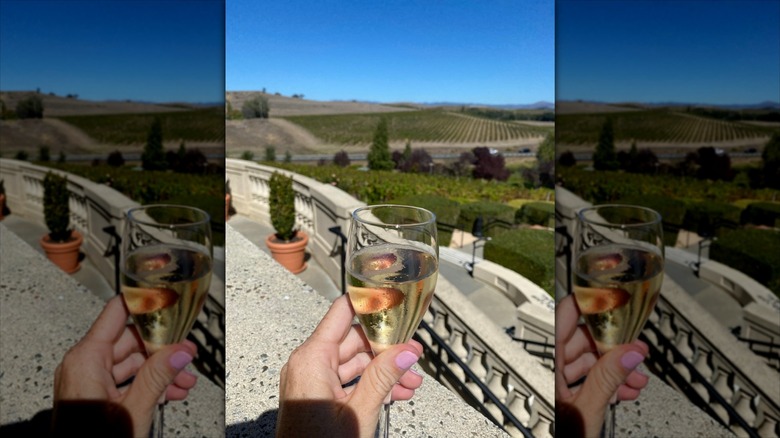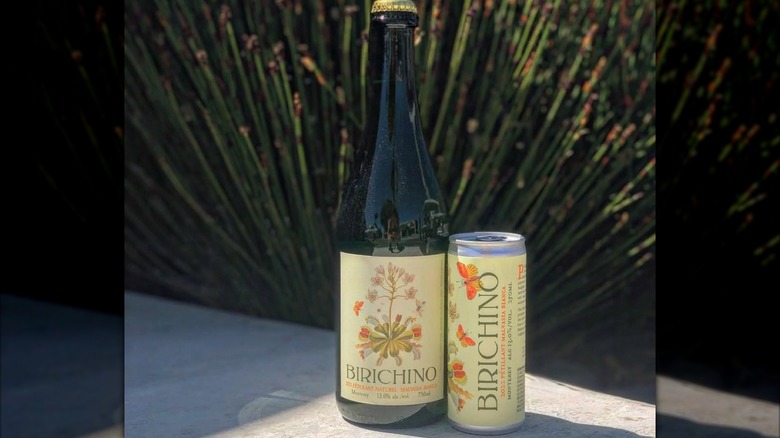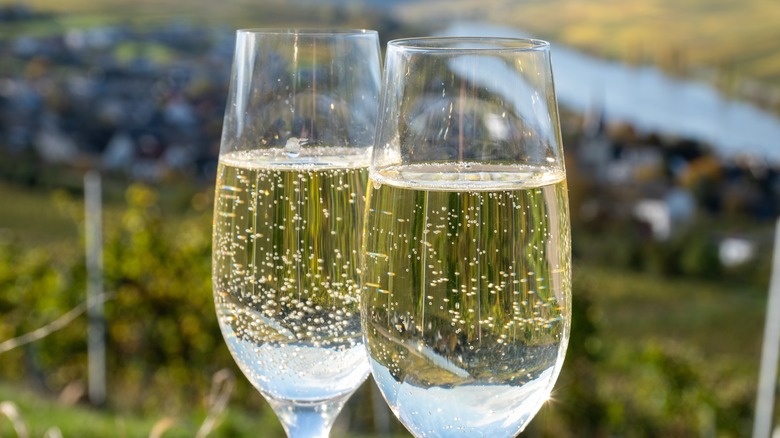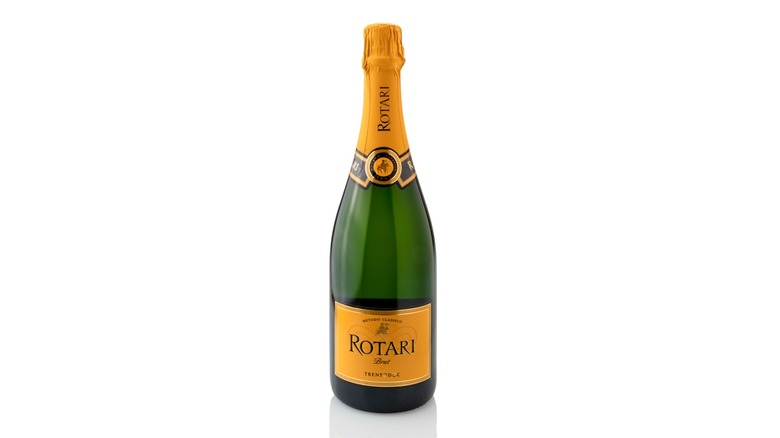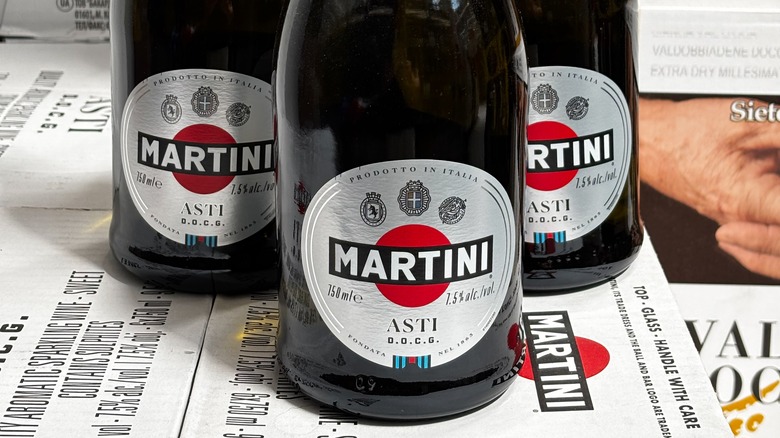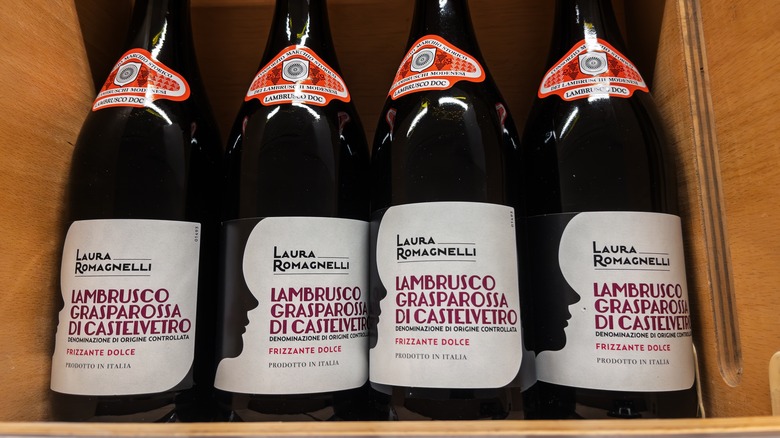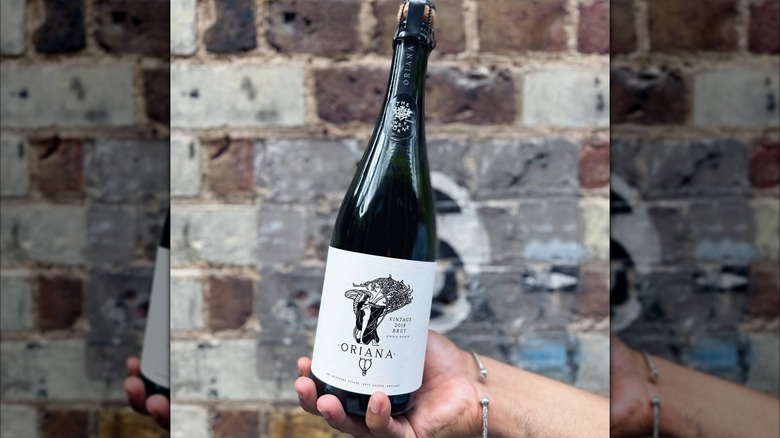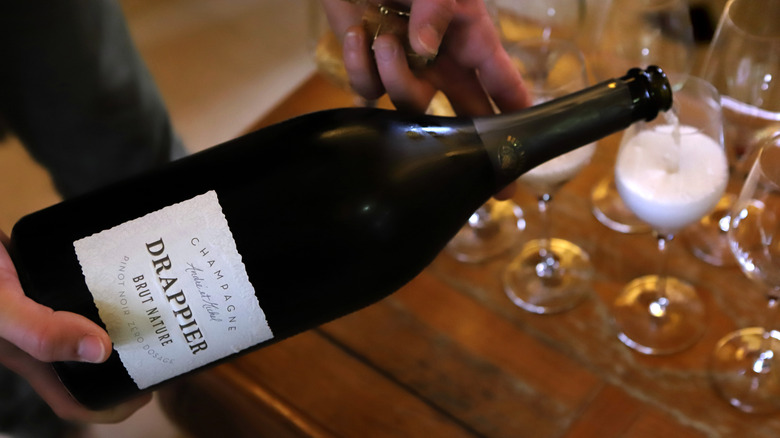Every Type Of Sparkling Wine Explained
While "Champagne" is a specific kind of alcoholic beverage, it's evolved into a generic, umbrella term that's interchangeable with "sparkling wine." Simply because Champagne looms large in history and European and American drinking culture, it's assumed that every sparkling wine is Champagne, and by extension, fancy and French. However, that couldn't be further from the truth.
Sparkling wine is made all over the world, and while many bottles may look, taste, and feel like French Champagne, they technically aren't. But there's nothing wrong with that. Transparent white wines with bubbles, a little bit of sweetness, and a boozy punch are often very similar to one another, but they all come from their own rich traditions and scientific processes.
As party season rolls around each year, you can guarantee a lot of popping corks and festive, effervescent wine being poured into glasses and flutes. Here are many of the major sparkling wines that you might encounter, and what makes each of them so special and also different from one another.
Champagne
In France, the Appellation d'Origine Contrôlée governs the use of the word "Champagne." While some contest the true origins of the beverage, the most widely accepted story is that Champagne was first refined in the Champagne region of northeastern France. As a result, only sparkling white wine produced there can technically, legally, and correctly be sold with the word "champagne" on the label. Since 1941, this has been enforced by the trade association, the Comité Interprofessionnel du vin de Champagne.
Legend has it that champagne has its roots in the late 15th century, when a sudden freeze across Europe stopped the fermentation of grapes for a number of wines bottled by monks at Champagne's Abbey of Hautvillers. After a thaw, the wines began to ferment anew, which created an abundance of carbon dioxide, adding a rolling fizz of bubbles to the wine. While we now know it's more legend than reality, the story has long been that a monk known as Dom Perignon supposedly figured out the secret to Champagne in the 1600s when he was tasked with making the local bubbly white wine have even more bubbles.
Champagne is still made today using two fermentation processes, the French method (also known as the traditional method). Eight grapes are allowed to be used in Champagne, which is often a blend. The most commonly employed are Chardonnay, Pinot Noir, and Pinot Meunier, along with Pinot Gris, Pinot Blanc, Petit Meslier, Arbane, and Voltis.
Prosecco
Probably the second-most famous and globally available sparkling white wine from Europe, behind Champagne, is Prosecco. Inside the northeastern Italian region of Veneto is Conegliano Valdobbiadene, where most real Prosecco originates. For centuries, Prosecco was made with, well, Prosecco, a grape long cultivated in northern Italy. In 2009, Italy sought and received legal protection for wines labeled as Prosecco, much like how Champagne is also protected. As part of that procedure, Prosecco grapes were renamed Glera, and a bottle of Prosecco can only be called that if the wine inside is made with 85% Glera grapes or more.
Glera is such a favorable wine grape because it tends to be prolific. Prosecco is sold in varying levels of sweetness and dryness (although it's most often extra dry). It is also distinctly fruity, giving off notes such as melon, peach, and pear. Generally, Prosecco is a light-bodied, crisp wine, which comes from a slightly different carbonation method. Quicker and less expensive than the traditional French method of secondary fermentation happening in the bottle, Prosecco gets its bubbles in a tank, before it's packaged and corked.
Cava
With roughly 250 million bottles made and distributed every year, this Spanish sparkling wine is popular in North America, particularly through more budget brands such as Segura Viudas and Freixenet. About 95% of Cava is made in Penedès, a region that's part of Catalonia and not too far from Barcelona. The sparkling wine can be found in white or rosé varieties, but the former is the overwhelming market favorite. Traditionally, white Cava is a mixture of Macabeo, Xarel-lo, and Parellada grapes, and the wine is light- or medium-bodied with small bubbles, a creamy texture, and notes of nuts and citrus.
Cava acquires its bubbles by what's known as the traditional method, the same process used to make French Champagne, with secondary fermentation happening inside the bottle. The product is so similar to authentic Champagne that, until the 1970s, it was actually marketed as Spanish Champagne. Spanish winemakers subsequently adopted the name Cava — Spanish for "cave" or "cellar," which is where wines are made and stored – for the product, and in the 1980s, Cava received Denominación de Origen status as Spain joined the European Union.
Sekt
Sekt is sparkling wine produced in Germany. The word means "sparkling wine" in the German language, but it's not a protected distinction in the same way that Champagne and Prosecco are in France and Italy, respectively. Until relatively recently, it wasn't widely known outside of Germany, where there are about 2,000 Sekt producers. Historically, it's been a cheap, commonplace, ho-hum kind of wine, mass-produced in factory settings by Germany-based wine makers from whatever grapes they could get from around Europe, not necessarily and usually not even domestically grown.
The Sekt industry developed when German winemakers studying fermentation techniques in Champagne returned to their home country to make their own wines. After World War II, Germany ramped up industrial Sekt production as a relatively quick, cheap, and easy way to get a lucrative wine industry going, utilizing tank fermentation, just like how Prosecco is made. Today, varieties of Sekt tend to use commonly found grapes, and more and more ones cultivated in Germany, such as Chardonnay, Pinot Noir, Muskateller, and most of all, Riesling.
Cap Classique
Farmers have been growing grapes in South Africa, a country that does a cookout like no other, for hundreds of years, but its sparkling wine industry only kicked into gear in the 1970s. That's when Simonsig Family Vineyards owner Frans Malan visited Champagne, learned about in-bottling fermentation, returned to South Africa, and used the country's signature and most prevalent wine grape, Chenin Blanc, to make Cape Sparkle. As the industry developed, such products acquired the name Cap Classique, with more than 220 local sparkling wine makers operating in South Africa today.
Because there are no ingredient limitations connected to Cap Classique, producers are free to experiment with what's still very much a work in progress. Cap Classique wines are most often white grape-based, or blanc de blanc, while rosé styles are also made. Some still make use of the Chenin Blanc grape, but others also rely on the likes of Chardonnay and Pinot Noir. The taste has been described as acidic, with some boasting a certain earthy flavor brought on by the limestone found in South African soil.
New World
Until the 20th century, the world's sparkling wine industry was primarily dominated by Western Europe, particularly France, Italy, and Spain. Those were also some of the leading nations in the Age of Discovery, when the Americas were regarded as the New World. That's the same designation – albeit a loose and large unofficial one — that the wine world has bestowed upon bubbly wines produced in North America and South America, as well as in the likes of late-breaking hotbeds such as Australia and New Zealand.
Many areas in the Western Hemisphere (and Oceania) have a similar climate to Western Europe, particularly California, where it's illegal to add sugar to wine before or during fermentation. The cooling impact of the ocean makes for the mild temperatures necessary to grow crucial wine grapes like Chardonnay and Pinot Noir in the Napa Valley's Carneros region, the Russian River Valley in Sonoma County, and Mendocino's Anderson Valley. California sparkling wines can, and have, contended with French champagne in competition. Argentina, Brazil, and Chile are leading producers of sparkling wine in South America, adapting the techniques lifted from the making of Champagne and Cava. Australia's Yarra Valley and Tasmania both make a lot of sparkling wine, as does New Zealand, with a fruit-infused line out of Marlborough.
Pétillant-Naturel
Champagne got the whole world familiar with the idea of sparkling wine fermented in a certain way to produce a sweet-dry taste and rippling bubbles. But it's actually pre-dated by a different French wine, one made in a different manner and possessing a unique flavor profile and mouthfeel. That's Pétillant-Naturel, and it's a sparkling wine that acquires its carbonation through just one fermentation process.
Pétillant-Naturel wine isn't aged hardly at all. The very nature of that in-bottling, singular fermentation — or the ancestral method, named for the fact that it's been used since the early 1500s — results in a carbonation level significantly lower than that of dominant sparkling wines, as well as a slightly lower alcoholic content, topping out at about 12%.
Made primarily in France, as well as by some progressive winemakers in the likes of California, Oregon, and New York, Pétillant-Naturel is a bit sweet from the presence of non-fermented sugar left in the grape juice. Notably, a Pétillant-Naturel wine is more likely to be sealed with a metallic crown cap, similar to a beer, than a cork.
Crémant
Champagne isn't the only sparkling wine that's produced in France. Often overlooked is Crémant, a sparkling wine made in eight specific regions of France and in the neighboring Moselle region of Luxembourg. Subject to France's stringent wine production and labeling laws, but not quite to the same degree as Champagne, a vast collection of grapes can go into the creation of Crémant, so long as it utilizes secondary, in-bottle fermentation (just like Champagne does).
About half of all true Crémant wines are of the Crémant d'Alsace style, or appellation. While it's known for a rosé built entirely out of Pinot Noir, the sparkling wines here are white grape-forward blends. Auxerrois, Pinot Gris, Riesling, and Chardonnay may be utilized, but they'll consist primarily of Pinot Blanc. The semi-arid weather and nearby mountains make for ideal soil and grape-growing and ripening conditions in Alsace. The result is a fresh, aromatic Crémant.
Trentodoc
A lack of Italian wines on the menu is a sign you're at a bad Italian restaurant, because the European country has so many interesting ones, regular and sparkling, from which to choose. Among them is Trentodoc, a sparkling wine produced and bottled only in the mountainous Trentino area in northeastern Italy.
The Dolomites guard against frigid winds while breezes off of Lake Garda create an ideally temperate climate for the growth of wine grapes such as Chardonnay and Pinot Noir, as well as some volume of Pinot Meunier and Pinot Blanc. About 50 vintners operate across thousands of acres, and while the grapes used are the same as those used in Champagne, as well as the secondary fermentation-in-bottles technique, the mineral-heavy soil adds another dimension of taste and texture.
In 1902, Giulio Ferrari studied wine in France, brought back what he learned to Trentino, noticed the similarities, and got to work. The main Trentodoc winery, Ferrari Trento, is today still run by the descendants of Bruno Lunelli, to whom he entrusted the land.
Asti Spumante
Sweet, bright, and fruity, one might very easily pick up on hints of peaches, apricots, pears, honey, and honeysuckle when they have a sip of Asti Spumante. With a creamy texture, lots of bubbles, and a grapey aroma, Asti Spumante is a de facto dessert wine, and a good one for slowly sipping.
It's made from one of the longest cultivated and sweetest wine grapes out there, the Moscato or Muscat, which has been grown in the Piedmont area of northern Italy for hundreds of years. According to legend, the first sparkling Asti was created by winemaker Carlo Gancia, who took their knowledge of Champagne production methods and used them with the grapes in Canelli, a town in the province of Asti.
Asti Spumante (which is Italian for "sparkling wine of Asti") remained a local favorite until World War II, when soldiers from the U.S. and elsewhere stationed in Italy loved it and brought bottles home. That created a large, global market for Asti Spumante, launching industrial production with fermentation occurring in tanks, rather than bottles. As part of its geographic protection, Asti Spumante must be made solely from Moscato Bianco grapes and finish with an average alcohol level of 7% to 9%.
Lambrusco and Brachetto d'Acqui
Almost universally, sparkling wine is white or, occasionally, a rosé. However, Italy makes a number of purely red wine-based offerings. From the Emilia-Romagna area comes Lambrusco, generally regarded as one of the least costly wines in wide distribution.
Moderately acidic with lower tannins and body than what's usually found in a bold and strong red wine, Lambrusco's alcohol content is also lessened, typically sitting at around 11%. It's a sparkling wine, but often a barely sparkling one. Lambrusco boasts far fewer bubbles than your average bottle of Champagne and is produced in a range from secco (or dry) to dolce (sweet). No matter where it falls on that scale, Lambrusco tastes strongly of berries and cherries, and these wines pair well with savory foods.
Another Italian sparkling red is Brachetto d'Acqui. The Brachetto grape is red, floral, and imparts a candy-like flavor, along with moderate acidity and a faint body. It's also sweet, which makes the average Brachetto measure an alcohol content of around 6%.
English sparkling wine
It's only a historically influenced myth that British consumables are boring and bland. Regions such as Sussex, Kent, and Hampshire are some of the newest players on the world's sparkling wine stage. Several major French Champagne houses opened vineyards and facilities in and around the area after discovering that the climate and soil are very similar to those of Champagne, France, and perhaps even enjoying a longer grape-growing season (thanks in no small part to climate change).
By and large, the wines grown there taste luxurious, with a rapid rate of bubbling and a body that's punchy and acidic with notes of fruits and nuts. Sparkling wine companies there obtain fermentation through the secondary fermentation process in the bottle. In 2022, Sussex sparkling wine was given the same protected designation of origin status as Champagne, meaning a glass of English sparkling wine can be more properly called a glass of Sussex.
The sweetness scale of sparkling wine
Sparkling wine tends to carry some element of sweetness. It's made from naturally sugared grapes, and yeast feasts on that sugar to bring on fermentation, after all. However, the final, finished product will be of a different sweetness at the producer's discretion.
Internationally, sparkling wine makers use a scale that indicates dosage, or the relative level of sweetness. A couple of words on the bottle of any style of sparkling wine is shorthand for how sweet the product inside will be, as well as the volume of alcohol (the sweeter the wine, the less boozy it will be). Not every sparkling wine is available in every level, but they all follow a similar metric that ranges from the dry, or "brut" end to some of the sweetest wines you can sip. Generally speaking, and in English-speaking areas, the scale goes from dry to sweet: Brut Nature, Extra Brut, Brut, Extra Sec, Sec, Demi-Sec, and Doux.
